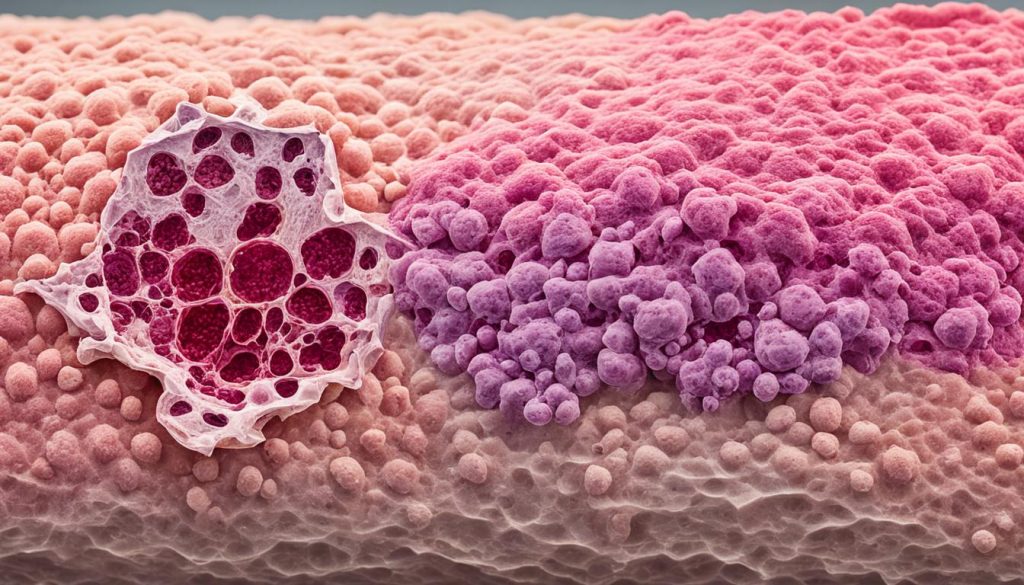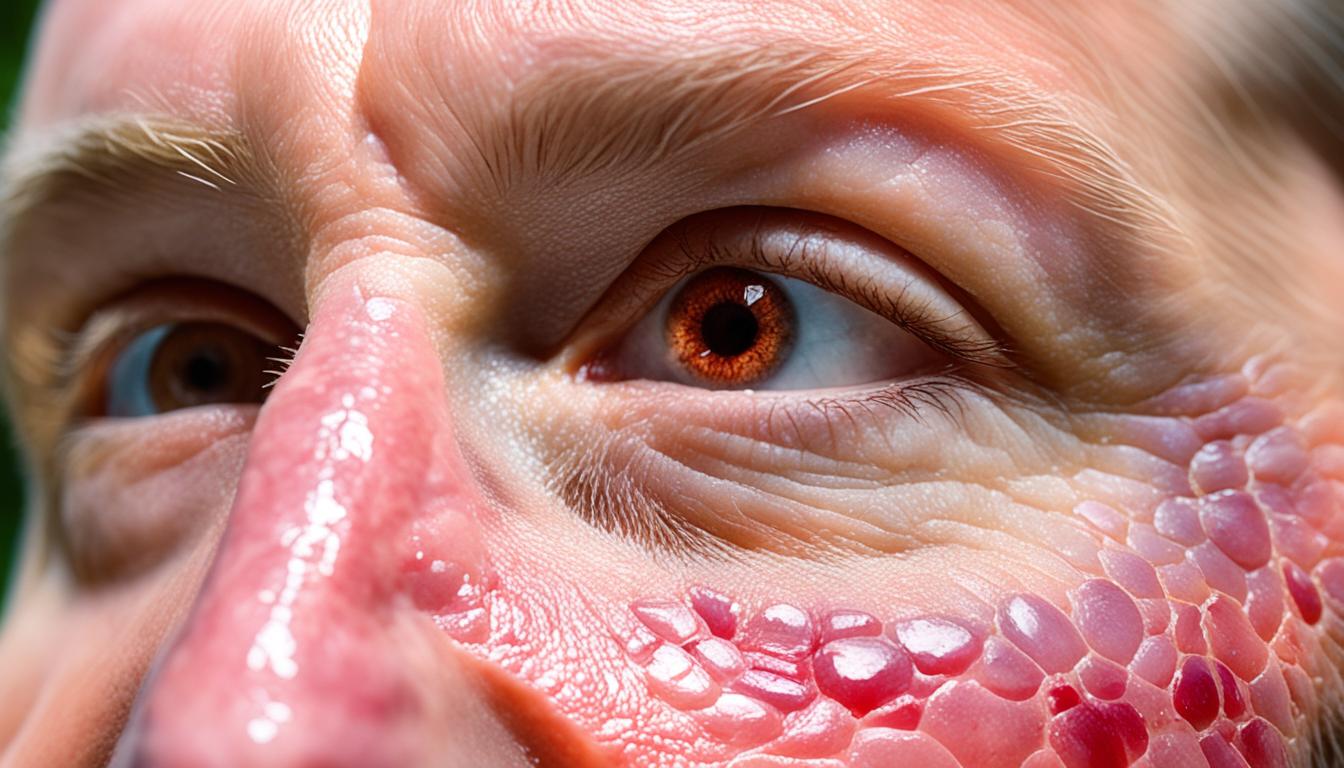Basal cell carcinoma (BCC) is a type of skin cancer. It starts in the basal cells. This cancer is common around the world. It looks like a see-through bump on areas of skin that get a lot of sun, such as the head and neck. The sun’s ultraviolet rays are the main cause of BCC. This is why people with light skin or those who have been in the sun a lot are often affected.
It’s key to spot basal cell carcinoma early for the best chance of treatment. Look out for new growths, sores that won’t heal, or scaly patches. BCC can look different depending on the color of your skin, like on white or brown skin.
Knowing what raises your risk for skin cancer is important. The sun, radiation therapy, having light skin, being older, and a history of skin cancer in your family all play a part. So does exposure to arsenic.
But, you can fight back against basal cell carcinoma. Stay out of the sun when it’s strongest. Wear sunscreen and clothes that protect you. And avoid tanning beds. These steps help lower your risk of getting BCC.
To diagnose BCC, doctors often do a biopsy, which means taking a small piece of the skin to check. How they treat it depends on how serious it is and where it’s at. Surgery, special creams, vismodegib, and radiation are some ways to treat it.
Stem cell therapy could also help treat basal cell carcinoma. Scientists are looking into how stem cells might fix damaged skin and help it heal. This is a newer area of research.
Knowing the symptoms, causes, and how to get diagnosed and treated helps you tackle basal cell carcinoma. It’s also good to know about new treatments like stem cell therapy that might be coming.
Key Takeaways:
- Basal cell carcinoma (BCC) is a type of skin cancer that arises from the basal cells of the skin.
- Symptoms of BCC include the presence of growths, non-healing sores, and scaly patches on the skin.
- Risk factors for BCC include chronic sun exposure, fair skin, increasing age, and a personal or family history of skin cancer.
- Prevention strategies for BCC include avoiding peak sun exposure, wearing sunscreen and protective clothing, and refraining from using tanning beds.
- Diagnosis of BCC often involves a biopsy, and treatment options may include surgical excision, Mohs micrographic surgery, chemotherapy creams, vismodegib, radiation therapy, and stem cell therapy.
Understanding Basal Cell Carcinoma on White Skin
Basal cell carcinoma is a type of skin cancer that affects people with all skin types. This includes those with white skin. On white skin, it often looks like a bump that is skin-colored or pink. It’s usually found on skin that gets a lot of sun, like the face.
This bump is typically shiny and you can see through it. Sometimes, you might see tiny blood vessels too. On white skin, the bump can look pearly white. It’s key to know that this bump might bleed and form a scab.
Knowing how basal cell carcinoma shows up on white skin is very important. This helps with catching it early and treating it fast. It’s crucial to check your skin often. And if you see any strange bumps, growths, or changes, get medical help. This can stop the cancer from getting worse.
| Characteristics of Basal Cell Carcinoma on White Skin | Description |
|---|---|
| Skin Color | Skin-colored or pink |
| Surface Appearance | Shiny and translucent |
| Visible Blood Vessels | In some cases |
| Additional Color | Pearly white |
| Bleeding and Scabbing | Possible |
Recognizing Basal Cell Carcinoma on Brown Skin
Basal cell carcinoma shows up differently on various skin tones. On brown skin, it often looks like a bump that’s brown or glossy black. This bump usually has a rolled border. It’s often found on sun-exposed areas, like the face.
Spotting basal cell carcinoma on brown skin can be tricky. It’s harder to see the tiny blood vessels that are visible on lighter skin. So, the color and texture of the bump are key to identifying the condition.
The bump can bleed and form a scab. It’s very important to watch for any changes in the skin. This is especially true if they don’t go away or get worse over time.
Early detection and quick treatment are crucial to deal with basal cell carcinoma. It’s wise to do regular checks of your skin. Also, see a dermatologist every year. This helps spot any skin changes early and tackle potential skin cancer quickly.
Skin Cancer on Brown Skin: Atypical Presentations
On brown skin, basal cell carcinoma can look different than expected. This includes:
- A bump that is dark brown or black in color
- A lesion with a glossy or shiny appearance
- A sore or growth with an unusual shape or texture
- A patch that is dark brown, black, or gray in color
If you see any unique changes in your skin, it’s vital to get a check-up. Talk to a dermatologist for a professional opinion.
| Characteristic | Presentation on Brown Skin |
|---|---|
| Color | Brown or glossy black |
| Shape | Bump with a rolled border |
| Texture | May bleed and scab over |
Identifying Symptoms of Basal Cell Carcinoma
Symptoms of basal cell carcinoma pop up on body parts exposed to the sun, often on the head and neck. You might notice a growth or a sore that does not heal. Look out for a shiny, translucent bump. It may appear skin-colored or pink on white skin. On brown skin, it could be brown or glossy black.
The bump might have visible blood vessels. It can also bleed and form a scab. You may also see a lesion that is brown, black, or blue with a raised border. Or a flat, scaly patch with a raised edge. Sometimes, there’s a white, waxy, scar-like lesion without a clear border.

| Symptoms of Basal Cell Carcinoma | Description |
|---|---|
| Shiny, translucent bump | A bump that appears shiny and allows you to see through it. On white skin, it may look skin-colored or pink. On brown skin, it may appear brown or glossy black. |
| Blood vessels | The bump may have visible blood vessels. |
| Bleeding and scabbing | The bump may bleed and form a scab. |
| Brown, black, or blue lesion with a raised border | A lesion that is brown, black, or blue and has a raised border. |
| Flat, scaly patch with a raised edge | A patch that is flat with a scaly texture and a raised edge. |
| White, waxy, scar-like lesion without a defined border | A lesion that is white, waxy, and has a scar-like appearance without a clear border. |
Causes and Risk Factors of Basal Cell Carcinoma
Basal cell carcinoma comes from the basal cells in the skin. It often starts after too much sun. UV rays from the sun change the cell’s DNA, causing cancer. Other factors also make getting this cancer more likely.
Long-term Sun Exposure and UV Radiation
Being in the sun too much is a big reason why people get basal cell carcinoma. If you don’t protect yourself outdoors, your risk goes up. Both direct and indirect sun rays can cause it.
Radiation Therapy
Radiation treatment for other cancers can increase your risk. This therapy can harm basal cells’ DNA. That damage can turn into cancer.
Fair Skin
If you have light skin, you’re more at risk. Light skin gets damaged easier by UV rays. This damage can lead to skin cancer.
Increasing Age
Getting older raises your risk of this skin cancer. Older people have had more sun over their lifetime. Also, other risk factors add up as you age.
Personal or Family History
Having had skin cancer before means you might get it again. If your family has had it, you’re more likely to too.
Arsenic Exposure
Arsenic, a dangerous substance, can also raise your risk. You might find arsenic in some water, jobs, or medicines. It’s harmful and linked to cancer.
People out in the sun a lot or living where it’s sunny face higher risks. Bad sunburns and tanning beds can also make getting this cancer more likely.
Complications and Prevention of Basal Cell Carcinoma
Basal cell carcinoma can cause problems if not treated or managed right. It’s vital to know these complications and prevent them. This helps lower the chances of getting basal cell carcinoma or having it come back.
Complications of Basal Cell Carcinoma
Here are some complications from basal cell carcinoma:
- There’s a chance cancer might return after treatment. Staying on top of regular check-ups helps spot any signs early.
- Having basal cell carcinoma raises the risk of other skin cancers. This includes squamous cell carcinoma and melanoma.
- In rare cases, it can spread beyond the skin. It might reach nearby lymph nodes and other body parts.
Prevention of Basal Cell Carcinoma
To lower your risk of basal cell carcinoma, prevention is key. Here are some ways to prevent it:
- Staying out of the sun, especially during peak times, helps. This reduces skin damage and the risk of carcinoma.
- Use sunscreen with an SPF of at least 30. It protects against UV rays. Remember to reapply every two hours, or after being in water.
- Wearing protective clothes offers extra safety against UV rays. Think long-sleeved shirts, hats, and sunglasses.
- Steer clear of tanning beds. They emit UV radiation, increasing skin cancer risks.
Checking your skin regularly helps catch issues early. Look for new growths, changes in moles or freckles, and sores that won’t heal.
Conclusion
Basal cell carcinoma is a type of skin cancer starting in basal cells. It mainly comes from long sun exposure. Look out for skin changes like growths or sores that don’t heal.
Doctors diagnose it with a biopsy, checking a sample under a microscope. Treatments include surgery, creams, a drug named vismodegib, and radiation. Scientists are exploring stem cell therapy too.
To lower your risk, protect your skin. Use sunscreen, wear protective clothes, and avoid tanning beds. Check your skin often for any changes. Getting help early can lead to a good outcome. Being aware and careful helps fight this skin cancer.

